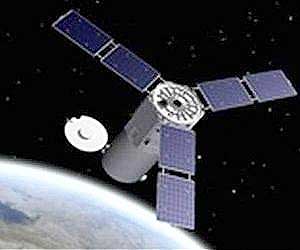In a Breaking Defense news feature just posted, the U.S. Navy wants the U.S. Army’s help win a future multi-domain battle with China, a senior defense official told the site's Deputy Editor, Sydney J. Freedberg Jr., last week — however, to get it, the two services have to connect through a simple, robust network using small and rapidly-launched satellites.

Artistic rendition of the ORS-1 satellite.
The senior defense official believes that massive bandwidth to handle video teleconferences, full motion video (FMV) from drones, PowerPoint briefings, and all the digital tools of “micromanagement,” are not needed. A regional command-and-control network for voice commands and bare-bones-data that offers I’m here, the enemy’s there, shoot them, not me – that can run off a single smallsat. He added that it doesn’t have to be a big network — you could have one satellite... a temporary smallsat that is popped up.
This is in keeping with the early Concept of Operation developed for the Air Force’s Operationally Responsive Space program (although the official didn’t mention ORS by name). ORS seeks to end the US military’s dependence on highly capable, highly complex and highly expensive satellites. These multi-billion-dollar masterpieces would take months or years to replace if an adversary shot them down — as China demonstrated it could do in 2007.
The Army could perform three key missions, the official said:
- Air & Missile Defense, protecting US air bases. The Army already plays a leading role here with its THAAD and Patriot batteries, but its fire control networks don’t connect to Navy ones. That’s something Pacific Command chief Adm. Harry Harris wants to fix.
- Land Attack, striking enemy launchers, sensors, and bases. Again, the Army already has some hardware for this role: the aging ATACMS missile, fired from HIMARS trucks and MLRS tracked launchers. The service is also developing a longer-ranged replacement, Long-Range Precision Fires – but LRPF’s range is still limited by the Intermediate Nuclear Forces treaty to under 500 kilometers.
- Anti-Ship, sinking enemy ships at sea. This is the Army’s newest mission (although the service ran coastal forts through World War II). The hardware is still in development under supervision of the Pentagon’s Strategic Capabilities Office: an anti-ship upgrade to ATACMS. The Army proposed this role as part of its Multi-Domain Battle concept, and Adm. Harris has eagerly embraced it.
“In all three (missions), they provide the same advantage, which is they have highly maneuverable, flexible units that are not fixed at a site like an airfield,” the official told Freedburg. “If I commanded a battalion of HIMARS, after I shot, the first thing I’d do is move, because if the enemy has overhead imagery (from satellites, spy planes, or drones), they’re going to be like, ‘Right there. Get on it.’ You want to be gone” before the retaliatory strike.

